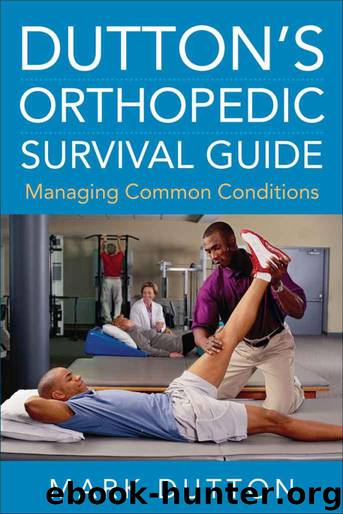Dutton's Orthopedic Survival Guide: Managing Common Conditions: Managing Common Conditions by Dutton Mark

Author:Dutton, Mark [Dutton, Mark]
Language: eng
Format: mobi
Publisher: McGraw-Hill Education
Published: 2011-02-28T05:00:00+00:00
* * *
The straight leg raise test may also be used as a screen for adverse neural tension, particularly of the sciatic nerve.
90–90 straight leg raise
The hamstring length can also be assessed with the patient positioned in supine and the tested leg flexed at the hip and knee to 90 degrees. From this position, the patient is asked to extend the knee of the involved side without extending the hip (Figure 8-15). The measurement is taken at the first resistance barrier.
Piriformis
The patient is positioned in sidelying. The clinician flexes the involved hip to 60 degrees. After stabilizing the patient’s pelvis, the clinician applies a downward pressure through the femur, and maximally adducts the involved hip. From this position, the hip is moved into internal rotation and then external rotation. Internal rotation stresses the superior fibers, while external rotation stresses the inferior fibers. Normal range of motion should be 45 degrees into either rotation. Pain is elicited in the muscle if the piriformis is adaptively shortened. There are no studies in the literature that discuss the sensitivity, specificity, positive predictive value, or negative predictive value of this maneuver.
Download
This site does not store any files on its server. We only index and link to content provided by other sites. Please contact the content providers to delete copyright contents if any and email us, we'll remove relevant links or contents immediately.
| Administration & Medicine Economics | Allied Health Professions |
| Basic Sciences | Dentistry |
| History | Medical Informatics |
| Medicine | Nursing |
| Pharmacology | Psychology |
| Research | Veterinary Medicine |
Periodization Training for Sports by Tudor Bompa(7934)
Why We Sleep: Unlocking the Power of Sleep and Dreams by Matthew Walker(6370)
Paper Towns by Green John(4811)
The Immortal Life of Henrietta Lacks by Rebecca Skloot(4267)
The Sports Rules Book by Human Kinetics(4084)
Dynamic Alignment Through Imagery by Eric Franklin(3928)
ACSM's Complete Guide to Fitness & Health by ACSM(3829)
Kaplan MCAT Organic Chemistry Review: Created for MCAT 2015 (Kaplan Test Prep) by Kaplan(3809)
Introduction to Kinesiology by Shirl J. Hoffman(3630)
Livewired by David Eagleman(3539)
The River of Consciousness by Oliver Sacks(3423)
The Death of the Heart by Elizabeth Bowen(3345)
Alchemy and Alchemists by C. J. S. Thompson(3301)
Descartes' Error by Antonio Damasio(3168)
Bad Pharma by Ben Goldacre(3110)
The Emperor of All Maladies: A Biography of Cancer by Siddhartha Mukherjee(2939)
The Gene: An Intimate History by Siddhartha Mukherjee(2932)
The Fate of Rome: Climate, Disease, and the End of an Empire (The Princeton History of the Ancient World) by Kyle Harper(2882)
Kaplan MCAT Behavioral Sciences Review: Created for MCAT 2015 (Kaplan Test Prep) by Kaplan(2824)
